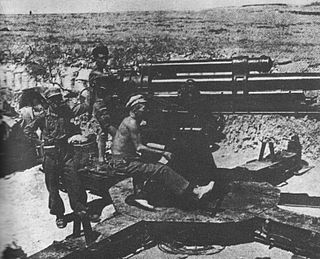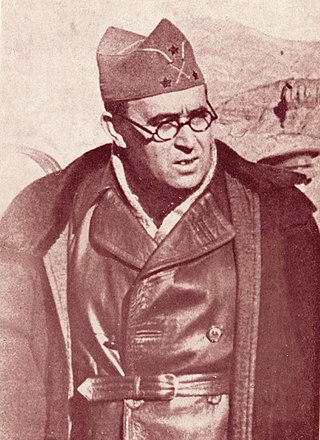Contents
| |||||
| Decades: | |||||
|---|---|---|---|---|---|
| See also: | Other events of 1939 List of years in Spain | ||||
Events from the year 1939 in Spain.
| |||||
| Decades: | |||||
|---|---|---|---|---|---|
| See also: | Other events of 1939 List of years in Spain | ||||
Events from the year 1939 in Spain.

The Battle of the Ebro was the longest and largest battle of the Spanish Civil War and the greatest, in terms of manpower, logistics and material ever fought on Spanish soil. It took place between July and November 1938, with fighting mainly concentrated in two areas on the lower course of the Ebro River, the Terra Alta comarca of Catalonia, and the Auts area close to Fayón (Faió) in the lower Matarranya, Eastern Lower Aragon. These sparsely populated areas saw the largest array of armies in the war. The battle was disastrous for the Second Spanish Republic, with tens of thousands left dead or wounded and little effect on the advance of the Nationalists.

Vicente Rojo Lluch was Chief of the General Staff of the Spanish Armed Forces during the Spanish Civil War. He is considered to have been one of the best commanders of the civil war.

Juan Negrín López was a Spanish physician and politician who served as prime minister of the Second Spanish Republic. He was a leader of the Spanish Socialist Workers' Party and of the left-leaning Popular Front government during the Spanish Civil War. He also served as finance minister. He was the last Loyalist premier of Spain (1937–1939), leading the Republican forces defeated by the Nationalists under General Francisco Franco. He was President of the Council of Ministers of the Second Spanish Republic and the Spanish Republican government in exile between 1937 and 1945. He died in exile in Paris, France.

Before this period, the Nationalists had already become dominant, yet the outcome of the war was still not certain. This progressively changed as the Nationalist forces notched up several victories.
The Second Battle of the Corunna Road was a battle of the Spanish Civil War that took place from 13 December 1936 to 15 January 1937, northwest of Madrid. In December 1936, the Nationalists launched an offensive in order to cut the Corunna Road and isolate Madrid, but a Republican counter-offensive stopped the Nationalist advance. The Nationalists cut the Corunna road but failed to encircle Madrid.

The siege of Madrid was a two-and-a-half-year siege of the Republican-controlled Spanish capital city of Madrid by the Nationalist armies, under General Francisco Franco, during the Spanish Civil War (1936–1939). The city, besieged from October 1936, fell to the Nationalist armies on 28 March 1939. The Battle of Madrid in November 1936 saw the most intense fighting in and around the city when the Nationalists made their most determined attempt to take the Republican capital.

The Battle of Teruel was fought in and around the city of Teruel during the Spanish Civil War between December 1937 and February 1938, during the worst Spanish winter in 20 years. The battle was one of the bloodiest actions of the war, with the city changing hands several times by first falling to the Republicans and eventually being retaken by the Nationalists. In the course of the fighting, Teruel was subjected to heavy artillery and aerial bombardment. In the two-month battle, both factions together took 110,000 casualties.

The War in the North was a theatre of the Spanish Civil War that occurred in northern Spain from 31 March to 21 October 1937.

The Aragon Offensive was an important military campaign during the Spanish Civil War, which began after the Battle of Teruel. The offensive, which ran from March 7, 1938, to April 19, 1938, smashed the Republican forces, overran Aragon, and conquered parts of Catalonia and the Levante.

The Catalonia Offensive was part of the Spanish Civil War. The Nationalist Army started the offensive on 23 December 1938 and rapidly conquered Republican-held Catalonia with Barcelona. Barcelona was captured on 26 January 1939. The Republican government headed for the French border. Thousands of people fleeing the Nationalists also crossed the frontier in the following month, to be placed in internment camps. Franco closed the border with France by 10 February 1939.

The XYZ Line, also known as the Matallana Line, was a system of fortifications built in 1938 during the Spanish Civil War to defend Valencia, the capital of the Second Spanish Republic. The XYZ Line was a simple system of trenches and bunkers, built to withstand heavy artillery or 450-kilogram (992 lb) aerial bombs, and took advantage of some of the most difficult terrain in Spain in the Iberian System ranges to the north and northeast of Valencia. The XYZ Line was successful at halting the Nationalist advance on Valencia, being one of the last Republican victories of the war, and allowed the Republicans to start the Battle of the Ebro.

Antonio Cordón García was a Spanish soldier, born in Sevilla, who commanded during the Spanish Civil War.

The Asturias Offensive was an offensive in Asturias during the Spanish Civil War from 1 September to 21 October 1937.

The Battle of Menorca was a battle that took place in Menorca during the Spanish Civil War between 7 and 9 February 1939. It was one of the last battles of the war and the last confrontation in the Balearic Islands.

The Cartagena uprising was an uprising that occurred in Cartagena during the Spanish Civil War from 4 to 7 March 1939.

The final offensive of the Spanish Civil War took place between 26 March and 1 April 1939, towards the end of the Spanish Civil War. On 5 March 1939, the Republican Army, led by Colonel Segismundo Casado and the politician Julián Besteiro, rose against the socialist prime minister Juan Negrín, and formed a military junta, the National Defence Council to negotiate a peace deal. Negrín fled to France but the communist troops around Madrid rose against the junta, starting a civil war within the civil war. Casado defeated them and started peace negotiations with the Nationalists. Francisco Franco, however, was willing to accept only an unconditional surrender. On 26 March, the Nationalists started a general offensive and by 31 March, they controlled all of Spanish territory. Hundreds of thousands of Republicans were arrested and interned in concentration camps.
Antonio Escobar Huerta was a Spanish military officer.
Francisco Galán Rodríguez (1902–1971) was a Spanish military officer.

The Levante Offensive, launched near the end of March 1938, was an attempt by Nationalist forces under Francisco Franco to capture the Republican held city of Valencia during the Spanish Civil War. The Nationalists occupied the province of Castellón, but the offensive failed due to bad weather and the dogged resistance of the Republican troops at the XYZ defensive line.

The National Defence Council was the governing body in Republican Spain at the end of the Spanish Civil War (1936–1939). The council seized power with Colonel Segismundo Casado's coup on 5 March 1939 when it was clear that the Republicans had lost the war. The leaders hoped to negotiate an end to hostilities with the rebel forces led by General Francisco Franco. However, Franco insisted on unconditional surrender, and on 26 March 1939 launched the final offensive of the Spanish Civil War. By the end of the month he controlled the whole country. Most of the council members escaped into exile on British warships.